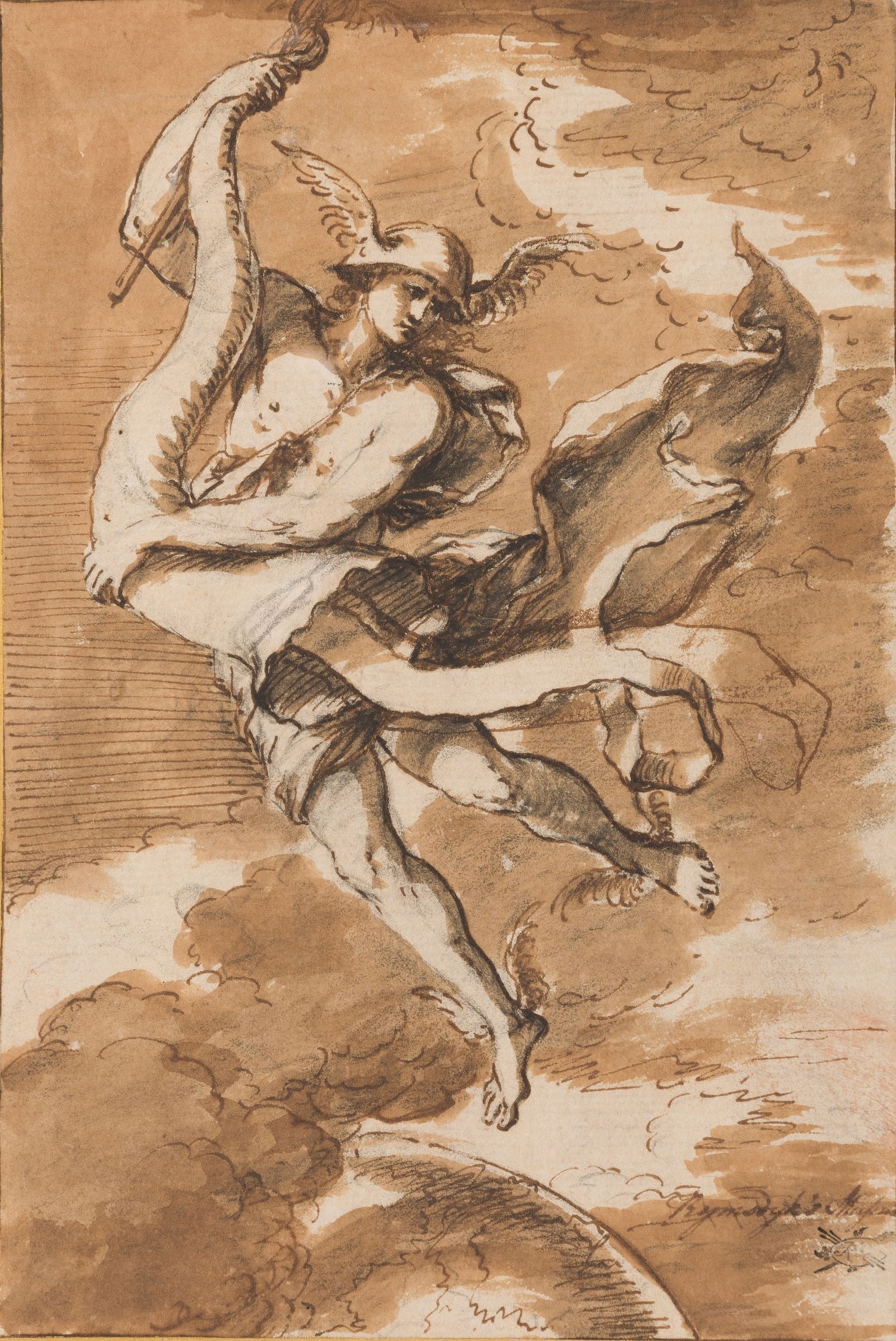Salvator Rosa
Mercury Bearing a Cornucopia: Design for a Frontispiece for Francisco Serra, Synonymorum apparatus, 1654
Rosa may have been inspired by a somewhat similar figure of Mercury that appears in the frontispiece to the 17th century German Jesuit scholar Athanasius Kircher’s Obeliscus Pamphilus, published in Rome in 16503. (Indeed, the artist is known to have met Kircher in Rome.) The imagery of both the present sheet and the related print anticipates that of Rosa’s painting of an Allegory of Fortune of 1659, in the J. Paul Getty Museum in Los Angeles, in which the female figure also bears a cornucopia. In stylistic terms, the present sheet may be compared with a number of Rosa’s preparatory studies for his celebrated Figurine series of etchings of soldiers, peasants and other figures, datable to c.1656-1657.
The English portrait painter, author and connoisseur Jonathan Richardson Senior (1667-1745), whose collector’s mark is found at the lower right corner of the sheet, owned a remarkable collection of nearly five thousand drawings. Richardson’s extensive collection, comprised mainly of Italian works of the 16th and 17th centuries, was assembled over a period of about fifty years, and was organized by school and date. The drawings were further classified with a complex system of shelfmarks, such as those found on the reverse of the mount of this drawing.
The present sheet also bears the inscription applied to drawings belonging to the 18th century Dutch-born painter and engraver Jan van Rymsdyk (1719-1790), who lived and worked in England, mainly as a medical illustrator, from around 1750 until his death. Van Rymsdyk (sometimes Riemsdyk or Rijmsdijk) organized his small but choice collection of drawings – mainly by Italian and Netherlandish artists – on similar lines to that of Richardson, and indeed acquired several drawings formerly owned by him. Rymsdyk purchased his drawings, which included several sheets by Rembrandt, on a modest budget, although, as Frits Lugt has noted, ‘He seems to have had an important collection of drawings; the inscription ‘Rymsdyk’s Museum’…is often found on beautiful sheets.’
The largest surviving group of drawings from Rymsdyk’s collection, amounting to eleven sheets, is today in the Pierpont Morgan Library in New York, while seven more are in the British Museum in London and five are in the Ashmolean Museum in Oxford. Other drawings with a Rymsdyk provenance are in the collections of the Rijksmuseum in Amsterdam, the National Gallery of Scotland in Edinburgh, the Walker Art Gallery in Liverpool, The Courtauld Gallery and the Victoria and Albert Museum in London, the J. Paul Getty Museum in Los Angeles, the Metropolitan Museum of Art, the Nasjonalgaleriet in Oslo, the Louvre and the Fondation Custodia in Paris, the Albertina in Vienna, and elsewhere.
Provenance: Jonathan Richardson, Senior, London (Lugt 2183 and on his mount)
By descent to his son, Jonathan Richardson Junior, London
Probably the posthumous Richardson Senior sale, London, Covent Garden, Christopher Cock, 22 January to 8 February 1747
Jan van Rymsdyk, Bristol and London (Lugt 2167), with his inscription Rymsdyk’s Museum at the lower right
Presumably his posthumous sale, London, Greenwood’s, 29 March 1790 [catalogue unlocated]
Pandora Old Masters, New York, in 2000
Private collection, Massachusetts.
Literature: Caterina Volpi, Salvator Rosa (1615-1673) “pittore famoso”, Rome, 2014, pp.138-139, fig.115.
Exhibition: New York, Pandora Old Masters, An Exhibition of Old Master Drawings & Oil Sketches, 2000, no.11; Boston, Museum of Fine Arts, Splendor and Elegance: European Decorative Arts and Drawings from the Horace Wood Brock Collection, 2009, no.116.
Plus d'œuvres d'art de la Galerie







_T638720600870834366.jpg?width=500&height=500&mode=pad&scale=both&qlt=90&format=jpg)

